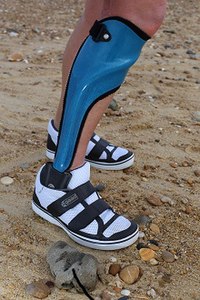
Photo from wikipedia
Background Assistive products are items which allow older people and people with disabilities to be able to live a healthy, productive and dignified life. It has been estimated that approximately… Click to show full abstract
Background Assistive products are items which allow older people and people with disabilities to be able to live a healthy, productive and dignified life. It has been estimated that approximately 1.5% of the world’s population need a prosthesis or orthosis. Objective The objective of this study was to systematically identify and review the evidence from randomized controlled trials assessing effectiveness and cost-effectiveness of prosthetic and orthotic interventions. Methods Literature searches, completed in September 2015, were carried out in fourteen databases between years 1995 and 2015. The search results were independently screened by two reviewers. For the purpose of this manuscript, only randomized controlled trials which examined interventions using orthotic or prosthetic devices were selected for data extraction and synthesis. Results A total of 342 randomised controlled trials were identified (319 English language and 23 non-English language). Only 4 of these randomised controlled trials examined prosthetic interventions and the rest examined orthotic interventions. These orthotic interventions were categorised based on the medical conditions/injuries of the participants. From these studies, this review focused on the medical condition/injuries with the highest number of randomised controlled trials (osteoarthritis, fracture, stroke, carpal tunnel syndrome, plantar fasciitis, anterior cruciate ligament, diabetic foot, rheumatoid and juvenile idiopathic arthritis, ankle sprain, cerebral palsy, lateral epicondylitis and low back pain). The included articles were assessed for risk of bias using the Cochrane Risk of Bias tool. Details of the clinical population examined, the type of orthotic/prosthetic intervention, the comparator/s and the outcome measures were extracted. Effect sizes and odds ratios were calculated for all outcome measures, where possible. Conclusions At present, for prosthetic and orthotic interventions, the scientific literature does not provide sufficient high quality research to allow strong conclusions on their effectiveness and cost-effectiveness.
Journal Title: PLoS ONE
Year Published: 2018
Link to full text (if available)
Share on Social Media: Sign Up to like & get
recommendations!